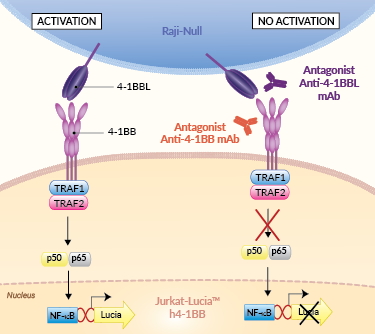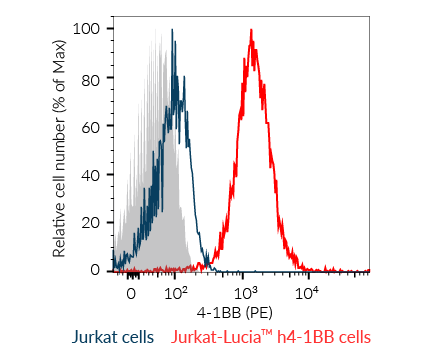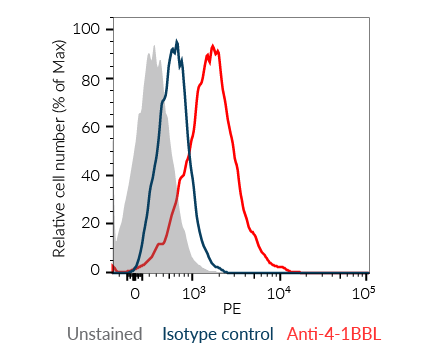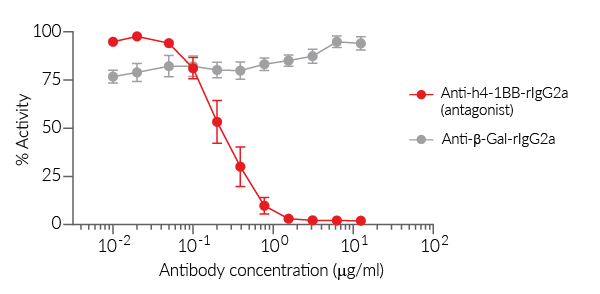Jurkat-Raji 4-1BB/4-1BBL assay (Bio-IC™)
| Product | Unit size | Cat. code | Docs. | Qty. | Price | |
|---|---|---|---|---|---|---|
|
4-1BB/4-1BBL Bio-IC™ 2 cell lines (Jurkat & Raji) based Lucia luciferase reporter assay |
Show product |
3-7 x 10e6 cells (x2) |
rajkt-41bb
|
|
Antagonist screening assay for 4-1BB/4-1BBL axis
InvivoGen offers a cellular assay specifically designed for screening antibody-, Fc-fusion protein-, or small-molecule antagonists of the 4-1BB/4-1BBL immune checkpoint (IC) axis. This assay is comprised of:

Principle of 4-1BB/4-1BBL cellular assay
(click to enlarge)
 InvivoGen also offers:
InvivoGen also offers:
• Agonist screening assay for 4-1BB/4-1BBL axis
• Fc-h4-1BBL fusion protein
- Jurkat-Lucia™ h4-1BB: Reporter T cells
- Raji-Null: Antigen-presenting cells (APCs)
These paired cell lines allow the mimicking of the 4-1BB-4-1BBL-mediated co-stimulation between T cells and APCs.
4-1BB (also known as CD137 or TNFSF9) is a member of the TNFR (tumor necrosis factor receptor) superfamily. In humans, 4-1BB is expressed on a multitude of cells of the hematopoietic lineage. It is found on the surface of activated CD8+ and CD4+ T cells, including regulatory T cells (Tregs) [1, 2]. The interaction of 4-1BB on T cells with its ligand, 4-1BBL (CD137L), on APCs, plays an important role in immune regulation. The 4-1BB/4-1BBL pair powerfully augments T-cell activation, proliferation, and survival and mediates memory T-cell generation [1, 2].
Note: If you are interested in a model that allows the mimicking of an immune synapse through T cell receptor (TCR) crosslinking with [HLA::peptide] complexes, along with the 4-1BB-4-1BBL costimulatory interaction, please contact us.
Assay principle:
This assay relies on the co-culture of Jurkat-Lucia™ h4-1BB and Raji-Null cells:
– Jurkat-Lucia™ h4-1BB cells stably express cell surface 4-1BB, along with an NF-κB-inducible Lucia luciferase reporter gene.
– Raji-Null cells express the 4-1BBL activating IC ligand.
In the presence of a potent 4-1BB or 4-1BBL antagonist, the 4-1BB-4-1BBL-mediated activation is blocked and there is no Lucia production. Activation of the reporter T cells can be readily measured using QUANTI-Luc™ 4 Lucia/Gaussia detection reagent (see figures).
T-cell key features:
- Stable human 4-1BB surface expression
- Fully functional 4-1BB signaling pathway
- NF-κB-inducible Lucia luciferase reporter activity
APC key features:
- High surface expression of human 4-1BBL
InvivoGen also offers Jurkat-Lucia™ h4-1BB cells without Raji-Null cells to measure the potency of agonists of the 4-1BB/4-1BBL axis.
![]() Read our review on Immune Checkpoint Blockade
Read our review on Immune Checkpoint Blockade
![]() Learn more about Immune Checkpoint Antibodies.
Learn more about Immune Checkpoint Antibodies.
References:
1. Bartkowiak, T. & Curran, M.A. 2015. 4-1BB Agonists: Multi-Potent Potentiators of Tumor Immunity. Front Oncol 5, 117.
2. Singh, R. et al., 2024. 4-1BB immunotherapy: advances and hurdles. Experimental & Molecular Medicine. 56(1):32-39.
Specifications
Growth medium: IMDM, 2 mM L-glutamine, 25 mM HEPES, 10% (v/v) heat-inactivated fetal bovine serum (FBS), 100 U/ml penicillin, 100 µg/ml streptomycin, 100 µg/ml Normocin™
Antibiotic resistance:
- Jurkat-Lucia™ h4-1BB cells: Blasticidin and Zeocin®
- Raji-Null cells: Blasticidin
Quality Control:
- Human 4-1BB and 4-1BBL expression is confirmed by flow cytometry.
- Reporter activity is validated following the co-culture of the two cell lines.
- The stability for 20 passages following thawing is verified.
- The cells are guaranteed mycoplasma-free.
Contents
Please note: Both cell lines are sold together.
- 3-7 x 106 Jurkat-Lucia™ h4-1BB cells
- 3-7 x 106 Raji-Null cells
- 1 ml of Blasticidin (10 mg/ml)
- 1 ml of Zeocin® (100 mg/ml)
- 1 ml of Normocin™ (50 mg/ml). Normocin™ is a formulation of three antibiotics active against mycoplasmas, bacteria, and fungi.
- 1 tube of QUANTI-Luc™ 4 Reagent, a Lucia luciferase detection reagent (sufficient to prepare 25 ml)
![]() Shipped on dry ice (Europe, USA, Canada)
Shipped on dry ice (Europe, USA, Canada)
Details
The 4-1BB/4-1BBL immune checkpoint
The 4-1BB/4-1BBL axis plays an important role in immune regulation and is considered an immune checkpoint (IC).
4-1BB (aka CD137 or TNFSF9) is a member of the TNFR (tumor necrosis factor receptor) superfamily. In humans, 4-1BB is expressed on a multitude of cells of the hematopoietic lineage. It is found on the surface of activated CD8+ and CD4+ T cells, including regulatory T cells (Tregs). Additionally, its expression can be induced on Natural Killer (NK) cells, B cells, monocytes, and dendritic cells (DCs) upon activation [1,2].
4-1BBL (aka CD137L) is also a member of the TNFR family and is known as the sole ligand for 4-1BB. In humans, 4-1BBL is expressed in T cells, B cells, DCs and macrophages [1,2].
The interaction of 4-1BB on T cells with its ligand, 4-1BBL (CD137L), on antigen-presenting cells (APCs), triggers a TRAF1/TRAF2/NF‑κB‑dependent signaling which powerfully augments T-cell activation, proliferation, and survival [1]. This co-stimulatory axis also mediates the generation of memory T cells [1]
The 4-1BB/4-1BBL immune checkpoint in cancer
4-1BB expression in activated T cells has been an attractive target for cancer immunotherapy. Different strategies have been explored.
Two human agonistic monoclonal antibodies (mAbs) directed at 4-1BB, utomilumab (PF-05082566) and urelumab (BMS-663513), have entered phase I/II clinical trials. Whereas the IgG2 utomilumab is safe with relatively low efficacy, the IgG4 urelumab has a great antitumor efficacy but causes liver damage [2,3]. Utomilumab is being extensively tested in combination with IC inhibitory antibodies (e.g. Anti-CTLA-4 and Anti-PD-1) to treat different tumors, such as non-small cell lung cancer, kidney, head, and neck cancer [1,3]. Of note, agonistic 4-1BB mAbs may act on the depletion of Tregs through Fc-mediated effector functions [3]. A new generation of 4-1BB agonistic mAbs, other than utomilumab and urelumab, are being tested and are referenced in [2].
4-1BB-derived domains have been widely studied as costimulatory domains for genetically engineered T cells expressing chimeric antigen receptors (CART). The activation of the 4-1BB signaling in these CART cells promotes the formation of memory CART cells and long-term immune response against cancer cells [2,3].
4-1BB is expressed in various types of hematologic cancers and 4-1BBL in tumor cells, including carcinoma and colon cancers. However, the precise functions of 4-1BB/4-1BBL remain unclear in these malignancies [1, 2].
References:
1. Bartkowiak, T. & Curran, M.A. 2015. 4-1BB Agonists: Multi-Potent Potentiators of Tumor Immunity. Front Oncol 5, 117.
2. Singh, R. et al., 2024. 4-1BB immunotherapy: advances and hurdles. Experimental & Molecular Medicine. 56(1):32-39.
3. Mascarelli, D.E, et al., 2021. Boosting Antitumor Response by Costimulatory Strategies Driven to 4-1BB and OX40 T-cell Receptors. Front. Cell Dev. Biol. 10.3389/fcell.2021.692982.










